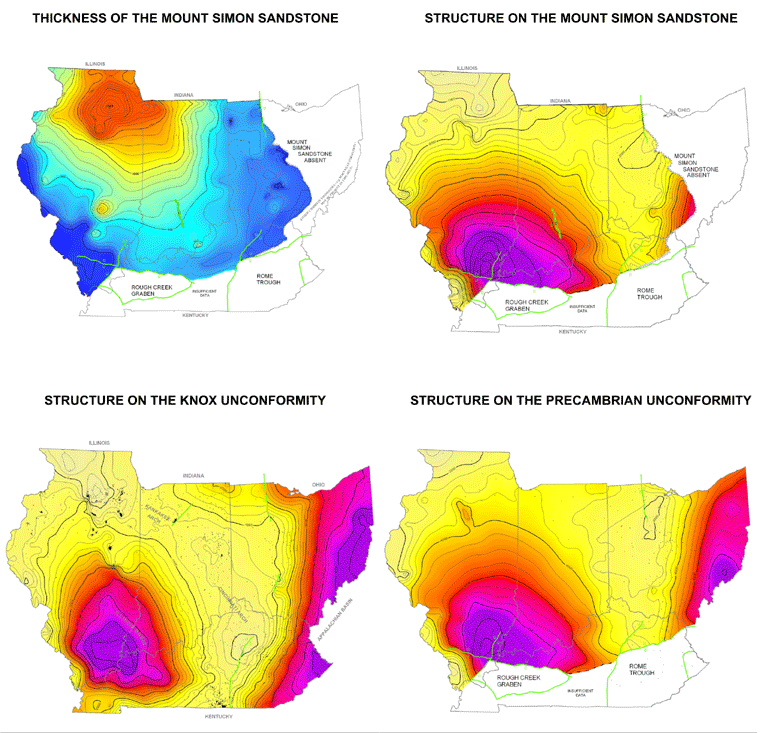 |

|
Kansas Geological Survey Open-file Report 2003-33 |
Cambrian-Ordovician Saline Aquifers
The Sauk Sequence is the lowest major sequence of rocks within the Paleozoic strata of North America. The Mount Simon Sandstone (Middle Cambrian) is the lowest unit in the sequence and was deposited on a major unconformity surface of eroded Precambrian-age strata. Within the southern portion of the region (Illinois, Indiana, Kentucky, Ohio), large Cambrian-age rift systems (Rome Trough and Rough Creek Graben) are present. Very few deep wells have been drilled to within these thick and complex rift sequences to allow characterization of carbon dioxide (CO2) sequestration potential.
The Mount Simon Sandstone is cited as an excellent candidate reservoir for CO2 sequestration. Favorable sequestration attributes include: relatively high porosity and permeability; lateral continuity over a multi-state area; thickness (up to 2,500+ feet); occurrence at depth beneath thousands of feet of alternating sequences of carbonate, shale, and sandstone; and stratigraphic position directly overlying relatively impermeable Precambrian-age strata. In addition, the Mount Simon underlies one of the most densely populated regions of the United States in close proximity to some of the nation's largest generators of CO2 emissions.
Previous interpretations of the Mount Simon have shown it to be present over most of Ohio and much of the Appalachian basin. However, current research at the Ohio Geological Survey indicates that the Mount Simon is absent in much of eastern and central Ohio. The basal stratum in these areas is mostly dolomite with interbeds of sandstone and sandy dolomite. While the Mount Simon is absent in this area, other Cambrian sandstones are found, such as the Maryville Formation, although their lateral continuity and overall extent are not well known at present. As more detailed maps on the occurrence and thickness of the Mount Simon and other Cambrian sandstones are generated, they will be posted to the MIDCARB website.
The Knox Unconformity surface defines the top of the Sauk sequence. Rocks of the Knox Group are very extensive, stretching across the interior of the North American Continent. The Knox Group is composed of dolomite and dolomitic sandstones. In eastern and central Ohio, this interval is an important producer of oil and gas from the Beekmantown Dolomite, Rose Run Sandstone, and Copper Ridge Dolomite. These fields may have potential for value-added sequestration. The Rose Run may also be an effective saline aquifer for storage of CO2 in parts of the Appalachian basin. In the western portion of the Arches Province and the Illinois Basin, the petroleum potential of Knox group remains largely untested. The paleokarst-related porosity systems within the Knox Group may be an effective CO2 reservoir in places throughout the region. However, it is shown mainly to define the top of the Sauk sequence, and as a 1,000 to 4,000 foot-thick interval of shale, siltstone, sandstone, dolomite, and limestone to contain any CO2 that may leak from a Mount Simon CO2 sequestration sites.
Generalized Contour Maps of the Sauk Sequence in
Illinois, Indiana, Kentucky and Ohio
Basic Tools for the Characterization of Saline Aquifers
for CO2 Sequestration
Compiled by
Wickstrom, L..H., M.T Baranoski, D.M. Powers, J.B. Hickman, W. Solano, C.P. Korose

|
|
Last updated June 2003
http://www.kgs.ku.edu/PRS/publication//2003/2003-33/P3-07.html